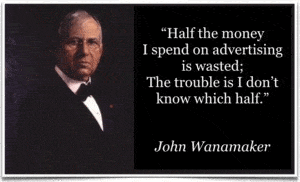
Top 100 Question: How to get your organization engaged in content marketing?
How to get your organization engaged in content marketing?
Why isn’t it easier to get your whole marketing team aboard with content marketing?
Many content strategists struggle to get their whole marketing team aboard with content marketing.
That’s why they ask questions like these:
- “How can other aspects of brand messaging (i.e., advertising, plus PR) better interact with the marketing content team?” a marketer at Kaiser Permanente asked.
- “How to get e-commerce engaged w/our content marketing strategy when they have their own strategies to adhere to?” a Walgreens marketer asked,
- “How do we successfully integrate content throughout marketing department functions?” asked a marketer at City National Bank.
- “How can an advertising and content team collaborate for maximum results?” a marketer at Farmers Insurance asked.
These 4 questions rank among the Top 100 Questions on content marketing. They’re answered below.
Why do marketers ask these questions about content strategy?
Oftentimes, it’s because advertising, PR, social media, blog posts, events, and other functions are in separate organizations, apart from content marketing. Each lives in its own separate silo.

Worse, the relationships among these functions can turn adversarial as they each compete for budget and talent.
When you ask content strategists, they sound more than a little frustrated with their internal situations.
They’re pointing at a crucial issue, too often unaddressed by senior leaders. The issue is: too many marketing peers don’t understand content marketing, what it is or how it works.
To collaborate effectively with others, both inside and outside marketing, content marketers must build a big tent, where others can help you co-create your content marketing mission, content marketing strategy, and marketing message.
People in PR, advertising, or social media can contribute to the content marketing cause with content creation and digital marketing assets. When you make others feel they’re a part of the content marketing team — insiders, not outsiders — you’ll be able to get farther with content.
The best content marketers get the whole company involved. Here’s how.

How to get people engaged in content marketing:
- Choose one of two approaches: either ask for permission or seek forgiveness.
- Create a space where content marketing has enough time to work.
- Build a strategic foundation for content marketing with an agreed-on mission, strategy, and message.
- Organize content marketing for success.
Where to start: permission or forgiveness?
Content marketing managers can take two paths to get people engaged in content strategy.
Either path is available when you’re working with a team inside Marketing or people outside the department. You can advance content marketing strategy by:
- Seeking permission upfront, or
- Asking for forgiveness later on.
In the long run, your company’s culture will determine which is the better path for you to take.
- Some companies encourage your entrepreneurial spirit — they’re ok with asking for forgiveness later on.
- But other companies demand that marketing rigorously follows the rules and approval processes.
Remember, your job is to get the whole team aboard with the content marketing program. Here are some ideas:
- Marcus Sheridan tells you how to recruit your team.
- Lis Korb helps you find people who can help you create content; here’s how.
- Meet with Sales regularly.
Lead with charm. You’ll catch more people with honey than vinegar.
Here we spell out the pros and cons of taking either the permission or forgiveness approaches.
Seek permission.

Start at top of the hierarchy, by winning support for content marketing from your CEO and CMO.
A permission-based approach is essential in small and medium-sized businesses. This approach can work in large businesses but only if marketing has strong direct support from the CEO.
If your CEO or C-suite is skeptical about marketing, winning permission for content marketing can take months or even years. Chances are, if it takes too long, you’ll become a distant object in competitors’ rearview mirrors.
Some companies try to catalyze content marketing by bringing in a parade of agencies and consultants to explain and get people engaged in content marketing. Taking this approach requires tremendous persistence. Why?
Executives are used to advertising, the fast-food of marketing.

Ads get quick results. Content does not.
For better or worse, content marketing is the slow food of marketing. Tastes great. Feels real. Made by hand.
But it seldom works fast.
The problems with advertising include these ugly truths:
- People are turning away from advertising in droves, using ad blockers, fast-forwarding through TV commercials, and throwing away junk mail.
- Help execs understand that content marketing, unlike advertising, is the marketing your customers actually want. In fact, they seek out great content.
- Measuring advertising results challenges even the best of the best marketers.
Attribution is particularly tough — it’s the #1 challenge consumer content marketers face. As John Wannamaker observed nearly a century ago, “Half the money I spend on advertising is wasted; the trouble is I don’t know which half.”

The world’s #1 advertiser, Procter & Gamble, discovered that the average view time for mobile Facebook news feed ads was only 1.7 seconds.
Ouch! That discovery led P&G to cut its ad spend by $200 million. How could that happen to a marketing powerhouse such as P&G?
Marc Pritchard, chief brand officer, told The Wall Street Journal, “As we all chased the Holy Grail of digital, self-included, we were relinquishing too much control – blinded by shiny objects, overwhelmed by big data, and ceding power to algorithms.”
Most advertisers find themselves in similar positions – uncertain about what’s working and what’s not working – yet afraid to abandon advertising. To many executives, it feels safer to stick with the status quo, rather than trying a different approach such as content marketing.
In contrast to the fast-food of advertising, content marketing is slow food.

It takes a year or two to see the full results of content marketing. Why?
Because it takes time to create brilliant content such as your content base. It takes time to get people engaged in your content and build an audience of subscribers.
The idea that content marketing takes more time to work is one challenge you face in seeking C-suite permission. But this crucial understanding needs to be baked into your agreement, upfront.
Otherwise, content marketing won’t get the time and space it needs to succeed.
Here’s a blog that can help content strategists: “How do we get executives to buy into content marketing?”.
Ask for forgiveness.

A quicker but riskier way to get the content started is to take a skunkworks approach. In technology companies, R&D does this all the time – why not do it in Marketing?
There are only 2 possible outcomes:
- If content visibly fails, you’ll need to ask for forgiveness.
- If content visibly succeeds, others in the company will want to jump on the bandwagon. Nothing succeeds like success in content marketing.
An organization that tolerates failure can achieve innovation. Content marketing is a great fit in such organizations.
It’s wise to start content marketing in a niche market, where you’ll have enough resources, attention, time, and space to prove that it works. To reduce the perceived risk, call your early content marketing a “pilot project.”
What if there’s no content marketing budget? Where can you find the money?
Here are 4 places to find funds to start up content:
- Establish a marketing experimentation budget of 15% and apply it to content.
- Squeeze savings out of other marketing projects to reinvest in content.
- Cut marketing deliverables that have unproven or unprovable results — such as all the money P&G spent on Facebook.
- Secure funds from a unit of the company that’s willing to become the guinea pig of content marketing.

Create a space where content marketing can have enough time to work.
Three promising places for a content marketing team to start building content strategy are short-cycle sales, orphans, and greenfields.
A short-cycle sale:
Is the type of sale where customers make decisions faster, revenue comes in quicker, and commissions are paid sooner. That’s why it’s a great place to start a content strategy because results become evident more quickly.
For example, in the telecom network equipment market, mobile telecom buyers take 12 to 30 months to reach a buying decision. But similar customers such as electric utilities reach decisions in as little as 3 to 6 months.
That’s why, at Tellabs, content strategists launched a content marketing pilot project with electric utilities instead of telecoms. Utilities’ quicker buying decisions meant we could demonstrate the effectiveness of content marketing much quicker.
An orphan:
Is it a product or a market that has gotten zero marketing support in the past year? It still has growth potential but suffers from neglect.
Most big companies have several orphan products or businesses that make great laboratories for content marketers to conduct fantastic experiments. You get more creative license because so little is expected from the product.
Adopt an orphan by providing attention, content marketing strategy, and digital marketing support. When the orphan’s sales rise unexpectedly, soon other internal clients will clamor for content marketing to support their products.
A greenfield:
Is a brand-new opportunity such as a new market or a new product. To start here, you must be willing to take a specific risk: Launch a new product solely with content marketing.
Big risk. Big reward.
By taking a big risk, you can attribute all the marketing results to the content marketing team. You head off all the questions about what percentage of the success should be attributed to content.
Once it’s proven to work for one product launch, it’s much easier to include content marketing in the marketing strategy for other new products.
Build a solid foundation for long-term content marketing.

Build a foundation for content marketing to succeed over the long haul with 4 steps:
- Start by gaining useful buyer insights through buyer persona research.
- Co-create the content marketing mission, content marketing strategy, and marketing message to gain buy-in.
- Organize and optimize the content marketing function for success.
- Build a strong content marketing base first, before you branch out.
To gain useful buyer insights, take one of two approaches.
Do buyer persona research to learn your buyers’ content needs.

Interview real prospects and customers who made purchase decisions in the past 3 to 6 months. Include a mix of people who bought from your company, bought from competitors, or stuck with the status quo.
Real buyer persona research shows:
- Why do people start the purchase decision process
- What exact needs buyers were addressing
- Where they sought and found information
- Which obstacles do they encounter
- How they overcame them to reach a buying decision.
If you only have one shot at proving content marketing works, insist on fielding buyer persona research. While demographics and segmentation research are useful, they are insufficient for strategic content marketing.
Here’s a detailed step-by-step process for how to do buyer persona research, based on Adele Revella’s book Buyer Personas.
Gather and analyze buyers’ questions to maximize content relevance.

Find out: What are buyers’ top 100 questions in your category? Using this 3-step process, you can squeeze every drop of meaning out of your buyers’ questions.
Start by gathering buyers’ questions in their exact words. Collect 1,000 or more verbatim questions.
Here are 14 ways to gather buyer questions:
1. Talk to customers face to face in a store or place of business.
2. Collect customer questions face to face at a trade show or event — by a survey.
3. Phone customers and interview them one-on-one.
4. Go on sales calls and note buyer questions.
5. Sit next to customer service reps in a call center and write down buyer and user questions. (Or give call center reps incentives to write down customers’ questions word for word. Or transcribe calls and hunt for the question marks.)
6. Gather questions from customer chat.
7. Harvest questions from customer e-mails.
8. Do a Google search and collect questions from the “People also ask” box.
9. Do a YouTube search and start to ask a question (without completing it) to see customer questions.
10. Use the BuzzSumo question analyzer, which aggregates questions from many websites, including Yahoo, Amazon and Quora.
11. Examine a topic on Answer the Public..
12. Search customer questions on Amazon.com.
13. Seek different questions at Quora.com or Reddit.
14. Ask sales or customer service to write down each question they hear from customers.
Text-analyze buyers’ questions.
Once you’ve gathered 1000 or more questions, load them into a spreadsheet and tag questions by key topic(s). Hire a text analyst to dig down and find out:
- Which buyer questions matter most?
- What do buyer questions reveal about the buyers’ journeys?
- Which obstacles do buyers hit?
- Exactly what content do they need to get past the obstacles?
Through text analysis, you’ll learn which questions are most important to buyers. That means you’ll be able to answer buyer questions with content that’s so relevant, they won’t be able to resist it.
Create a separate webpage to address each topic.
Don’t put all the questions and answers on the same FAQ webpage, because Google won’t understand the topic and won’t give the page a good search rank.
To home in on one topic, use buyers’ verbatim questions as headlines on each page. That assures that buyers will find your content when they Google these questions.
Here’s a step-by-step process I used to identify marketers’ top 100 questions about content marketing – which inspired this series of blogs.

Build a complete strategy for content.
Work with your executives, product managers, sales, and others to co-create a foundation for content marketing. Co-creation is crucial because it helps everyone buy into the content marketing mission, content marketing strategy, and marketing message upfront.
Here are the step-by-step processes you can use to create:
- A content marketing mission statement
- A 1-page content marketing strategy
- A concise, clear, consistent 7-second message on a Message Map.
Organize content marketing for success.
Content marketing requires a dedicated team. Organize it like a newsroom:
- Appoint an editor with the authority to schedule content, decide which content is ready to go, assign stories, and take responsibility for attracting subscribers.
- Assign content creators – writers, designers, photographers, and videographers – who create streams of content from day to day.
- Identify subject-matter experts who will work with content creators to produce content that fully reflects the company’s expertise.
With an agreed-on mission, strategy, and message, the content marketing team gets the authority to operate content marketing without getting bogged down in endless reviews.
One way to accelerate content marketing success is to bring together people from marketing and public relations (PR) under one roof. Both PR and marketing skill sets are essential to effective content marketing.
Combining their overlapping skill sets is a proven approach. Here’s why:

Avoid the organizational pitfalls that can hobble content marketing:
- Don’t make content into a “side job” that’s 10% of everyone’s job. That’s a guaranteed loser. A small dedicated content team can run rings around a large team that considers content its side job.
- Don’t miss the opportunities in the news every day. Speed increases content relevance. Use newsjacking – commenting on and amplifying the day’s news stories – to generate relevant content in a timely way.
- Don’t bog down content marketing with complex review processes. If content takes more than 1 day to review, the review process needs to be fixed.
Build a solid base to get people engaged in content marketing.
What is the single content deliverable that can make the biggest difference to your buyers? Is it a book? A magazine? A video series?
First, work on your content marketing base — one content type you will consistently deliver over a long period of time. Go deep by building a solid base, then go wide by branching out.
At first, concentrate most of your resources on building the base. For example:
- Michelin started with a book, the Michelin Guide.
- John Deere started with a magazine, The Furrow.
- Service Experts created a book, Home Heating & Cooling for Dummies.

Think of your content marketing base as the trunk of a tree – one type of content, consistently delivered over a long period of time, in any medium – blog, book, magazine, or videos.
Once you’ve built a solid base, the trunk of your tree, then it’s time to branch out.

Be careful to avoid spreading yourself too thin or trying to do too many types of content at once.
Unfortunately, too many marketers have had to learn this lesson the hard way – by spreading themselves too thin, then pulling back. Start small and build up; don’t try to cover the whole waterfront.
Focus on building a super-strong base first. Then branch out gradually.
How can you get your team engaged in content marketing? Follow these 4 steps:
- Choose one of two approaches: either ask for permission or seek forgiveness.
- Create a space where content marketing has enough time to work.
- Build a strategic foundation for content marketing with an agreed-on mission, strategy, and message.
- Organize content marketing for success.

Related Posts
Customer questions: ‘How can we uncover customer questions to develop better content?’
14 ways to discover buyer and customer questions Here’s one reason that content marketing works: Customers search the Internet for good answers to their...
In Content Marketing & Debates, Simple Messages Win
Marketers can learn a lot about winning messages from watching political debates. In U.S. presidential debates candidates get a chance, in a free marketplace of...
7 Content Marketing Lessons from Gardeners in Summer
How can you get the most from your established content marketing program? Like gardening, content marketing is demanding. It requires that you invest attention,...
Top 100 Content Marketing Question: How to measure good content?
How does content make your reader’s job easy? To measure good content is the first question to ask. It’s crucial to make content easy because...





